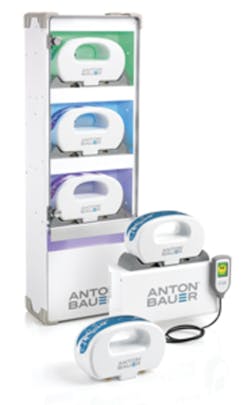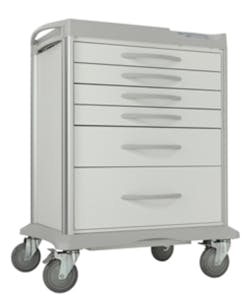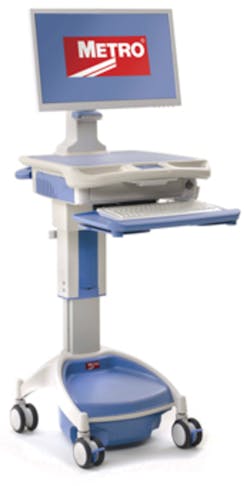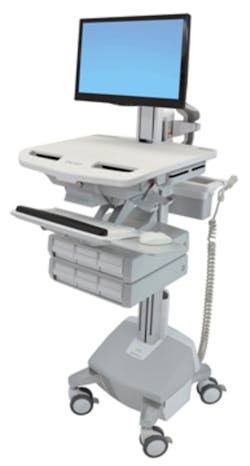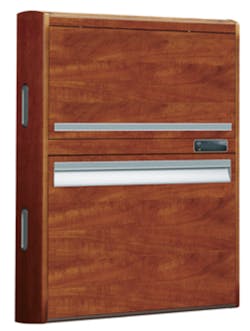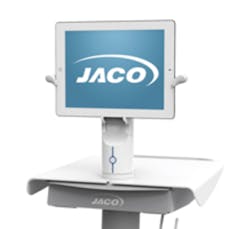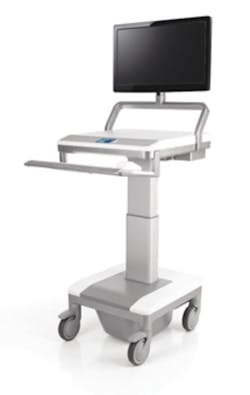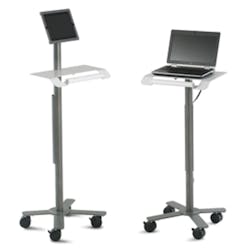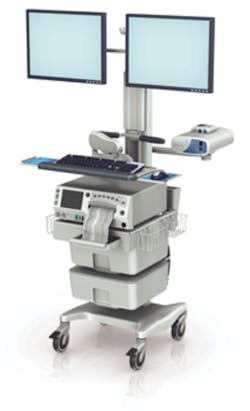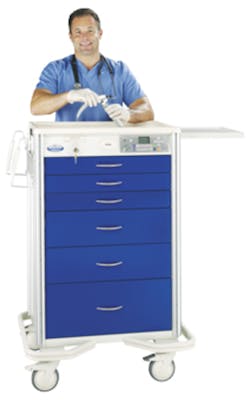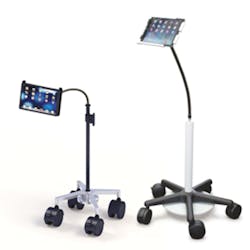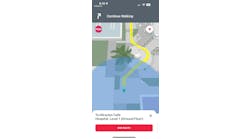Consider ergonomic factors for comfortable carts and workstations
The phrase, “form must consider function” takes special meaning within the context of healthcare mobile carts and workstations. As integral tools that can increase workflow efficiencies, positively impact the point of care and, in turn, improve the overall level of satisfaction of staff and patients, workstations must not only fit within an organization’s physical layout and its operational policies, but also fit the physical requirements of their users.
Ill-fitting or “mismatched” carts or workstations can lead to staff workers experiencing fatigue and even pain. Conversely, by properly integrating a workstation that provides its users comfort at the appropriate workflow position, a facility can achieve the highest levels of efficiencies and care.
We have included a brief overview of the ergonomic considerations administrators should make when planning to incorporate carts and workstations within their organization.
| Rubbermaid Healthcare’s new CareLink Mobile Nurse Station was built with ergonomics in mind. |
A comfortable place to work
Once thought of as little more than common furniture, the basic mobile cart can serve as a powerful tool at any healthcare facility. Simply by offering a comfortable place to perform important tasks, the right cart can increase productivity and satisfaction of your front-line staff.
Mobile carts and workstations can “enable quick, accurate decision making thanks to immediate access to data; reduce errors and enhance documentation accuracy as paper charting is eliminated; and provide access to patient data for all members of the circle of care, preventing duplicate efforts and providing accurate communication and clear care plan,” says Kimberly Krisik, Business Development Manager, CDW Healthcare. While these benefits are very real, many organizations do not appreciate the functionality of how workstations can affect their staff, thus limiting the equipment’s effectiveness.
“Scott-Clark (a LogiQuip Company) offers carts that are lightweight and have a low center of gravity,” said Bill Bzdek, Chief Operating Officer. “This allows for easy forward, backward and lateral movement.” When working at the cart, the user can adjust the desktop to the proper working height and then further adjust the monitor for the right sight position. A safer and more easy to use cart allows the worker to employ the cart for longer periods of time without injury.
The Armstrong Medical Premier cart line is all aluminum and 45 percent lighter than steel carts, minimizing end-user exertion. All full-size Armstrong carts are sold standard with a stabilizing frame with bumper. This extra-wide base provides the cart with added stability. The Armstrong Medical Premier Carts are seamless with no holes on the outside to retain spilled fluids – an infection-prevention consideration for patient and staff safety.
With the option of motorized or manual operation, the Getinge Height Adjustable Prep and Pack Workstation allows optimum ergonomic positioning between 28.6 inches and 44.1 inches from the finished floor. It has a high load capacity – 1,000 pounds for motorized units; 500 pounds for hand-crank units – and it has three different user positions that can be preset to store individual worker preferences, maximizing comfort and efficiency.
Belimed’s workstations are built to meet a wide range of U. S. and international ergonomic and human factors standards: ANSI/HFES 100-2007, ANSI/AAMI HE75-2009 and ANSA/AAMI/IEC 62366:2007. Adjustable unit, keyboard, monitor and shelf heights, and configurable keyboard, monitor and supply distance from the user, are all key features required by these standards and are provided by Belimed’s product offering.
Enhanced EMR efficiency
Carts and workstations with advanced ergonomic design and functionality can facilitate the use of EMR systems while preventing caregiver injury and strain.
“There are a number of features that are critical for facilities when implementing EMR and e-MAR systems. First and foremost, the workstation must be designed with ergonomics in mind to provide a comfortable and convenient user experience for caregivers,” said Rob Sobie, Vice President, Metro, adding that the new Metro AccessPoint Mobile Computing System was designed from the ground up to meet Cornell ANSI/HFES 100-2007 Human Factors Engineering of Computer Workstations ergonomic standards.
Alissa Kubera, Senior Product Manager, Rubbermaid Healthcare, emphasized flexibility and maneuverability when considering the use of a specific carts. “Making the carts easy to move is crucial for any organization implementing EMR or e-MAR systems. Workflows and facility configurations are highly variable, even within the same building, so a cart that is easy to move and adaptable for any size space is very helpful,” Kubera said.
Rubbermaid Healthcare’s new CareLink Mobile Nurse Station is equipped with large 5-inch casters to help cross thresholds and maneuver over carpet. “New to this workstation, our proprietary N-Stride steering control allows users to easily navigate halls and turn corners without unnecessary strain by switching the front casters from multi- to single-direction with the click of a trigger,” said Kubera.
CareLink features a 7-inch integrated glass touchscreen that allows for easy messaging capabilities, customized user settings and interactive tools designed to streamline care delivery, allowing clinicians to remain with the patient while comfortably performing their duties. “They can send and receive messages to and from other areas of the hospital, including IT, pharmacy and housekeeping, directly on the touchscreen computer without disrupting their EMR session,” said Kubera. “This increases response times and minimizes disruption to patient care. It also allows the caregiver to be more productive and efficient with each encounter.”
Even the most basic mobile cart can serve as a powerful tool at a healthcare facility. By offering a comfortable place to perform important tasks, the right cart can increase the productivity and satisfaction of your front-line staff.
Security and medication administration on the go
Few tasks are as important on the frontlines of healthcare as medication administration and the security measures needed to ensure patient safety and regulatory compliance. When implementing mobile carts and workstations, healthcare officials should make extra considerations to ensure the highest level of care and security.
On challenges related to striking a balance between the use of mobile computing solutions and healthcare’s unique security requirements, Andrea Bradshaw, CDW Senior Director and General Manager, Mobility Solutions, said, “Research tells us that security and mobile device management (MDM) are the biggest concerns keeping healthcare IT managers awake at night. In particular, the ability to offer staff, patients and visitors the freedom to use the devices and apps that make caregivers productive – all while upholding HIPAA requirements mandating that all patient data is secured at all times.”
CDW’s Total Mobility Management helps organizations determine and define their ideal mobile strategy, including mobile carts and workstations, and choose which devices and apps would best support its workforce. “We can guide IT managers to the right solution to protect the organization’s data – most importantly, its patient data,” said Bradshaw. “Through our Mobility Management Portal, we can integrate day-to-day IT operations into one screen and provide real-time views and alerts of usage, expenses, device location, non-compliant activity and other activity deemed important. For BYOD users, we offer 24/7 support through a help desk and self-service portal. CDW will customize the optimal Total Mobility Management solution and services for each specific healthcare environment, because we know that the right clinical mobility solution can improve quality of care, communication and convenience.”
The Armstrong wireless auto-locking cart offers added security with several programmable auto-lock features. Additional security options from Armstrong include badge access, dual locking controlled-substance drawer with audible alarm and software audit trail reports for accountability. The Wireless Auto-Locking cart with optional Controlled Substance drawer requires dual credential access. In addition, alarms (audio and visual) can be set to ensure drawers are secure. When using the software, accountability is also a key feature to view audit trails and track who has accessed the Controlled Substance drawer. It also offers keyless entry with programmable auto-locking in minutes or hours for up to 250 users. Its LCD display provides cart status information and allows for on-screen programming. With the integrated 802.11g wireless capabilities, managing the carts and users (up to 5,000) can be administrated remotely in only minutes.
Blue Bell Bio-Medical offers its new wireless auto-lock cart with optional controlled substance drawers. Susan Saam, Regional Manager, explained, “It allows user updates and lock settings to be managed from the convenience of an administrator’s office by utilizing the facility’s Wi-Fi network. Make the update once and it’s done, even for carts located at satellite facilities. No more docking to each cart.” Its keyless entry feature allows for multiple individual user codes and activity reporting. Proximity or Magstripe card readers may be added, and optional independently accessed drawers for increased security of controlled substances or other valuables are also available.
The WALLAroo units from Carstens can not only serve as secure computer stations, they also offer secure medication storage – both at the point of care. They can be secured with network IP access control, as well. They can be used as mobile diagnostic equipment carts to improve workflow and can integrate technology equipment with an on-board power supply. The LinkT cart enhances face-to-face communication with a built-in seat for the clinician.
Mobile Trends
NPs, PAs and pharmacists are top engaged mobile users
Nurse practitioners (NPs), physician assistants (PAs) and pharmacists excel at mobile, according to findings from the third annual Epocrates Mobile Trends Report, which examines mobile technology adoption and use patterns among healthcare providers.
More than 1,200 healthcare professionals from across the Epocrates member base shared opinions on mobile device usage and its impact on the medical profession and clinical workflow. Results were released in June.
Epocrates, an athenahealth service, led the digital health market in terms of medical reference app reach on smartphones for the fifth consecutive year in Manhattan Research’s 2014 Taking the Pulse U.S. study.
PAs lead daily tablet usage among clinicians, with NPs following close behind. As for hospital pharmacists, over half identified themselves as digital omnivores and designate mobile as having significantly improved their productivity while enhancing interactions with patients.
Interestingly, the report also notes that daily time spent on desktop computers by clinicians has increased this year over last, which is attributed to the increased adoption of traditional EHR systems.
Get the Epocrates Mobile Trends Report at www.epocrates.com
Patient Safety
ONC offers info on myriad patient safety issues
As part of an update in September 2014 to the ONC Health IT Safety Program – Progress on Health IT Patient Safety Action and Surveillance Plan, the agency noted that a study published in the summer of 2014 funded by HHS’ Agency for Healthcare Research and Quality (AHRQ) found that Florida hospitals that adopted all five core measures of Meaningful Use for medication management in 2010 had the lowest rate of adverse drug events of all hospitals in the state. The study is called “Meaningful Use IT reduces hospital-caused adverse drug events even at challenged hospitals.”
ONC also offers, via healthit.gov, the following guides and reports that it has funded to better understand the role of health IT in patient safety:
- “How to Identify and Address Unsafe Conditions Associated with Health IT” – This ECRI Institute resource helps healthcare providers and EHR technology developers identify and report health IT-related events to PSOs.
- “Promoting Patient Safety Through Effective Health Information Technology Risk Management” – This RAND report identifies challenges and success factors for implementing effective risk management related to health IT.
- “The Role of Health IT Developers in Improving Patient Safety in High Reliability Organizations” – This guide by the National Center for Human Factors in Healthcare makes 18 recommendations on how health IT developers can help their clients optimize the safety and safe use of their products and services.
Solutions
The Elora Modular Battery System is an innovative solution designed to dramatically transform battery management for any portable point-of-care technology, including mobile workstations, vital signs monitors and EKG monitors, and meet strict agency safety standards, such as the IEC 60601-1 3rd edition. This system enables uninterrupted workflow by eliminating the time-intensive and onerous tasks previously associated with battery management, letting nurses and other healthcare professionals dedicate additional focus to patient care. Anton/Bauer
Managed Mobile Services is an all-inclusive suite of mobile device and application management tools to help address the concerns of sensitive data in a mobile environment. Clinicians benefit from knowing their private emails, photos and personal applications are untouched, while IT administrators can help ensure patient data is secure. These mobile services enforce security requirements for your bring-your-own-device policy, while providing IT administrators with access to a real-time, easy-to-use dashboard to manage end-user devices. McKesson
The Harmony 7000 cart with Intelligent Locking System (ILS) is part of STANLEY Healthcare’s leading Supply Chain Storage Solutions. The ILS offering is a keyless-entry solution that uses proximity card access supported with software through a Wi-Fi connection. ILS offers hospitals an easy, time-saving way to manage a large fleet of storage carts, providing remote credential and setting management, audit reports and battery status – all from a single administrator computer. STANLEY Healthcare
The all-new Metro AccessPoint Mobile Computing System delivers an unmatched user experience for both caregivers and IT professionals. It is the only mobile computing workstation to meet or exceed all of the Cornell University Healthcare Cart Ergonomic Standards (a stringent 35-point checklist measuring ease of use, safety and effectiveness of carts). Additionally, the advanced Li-Nano batteries deliver twice the life of typical LiFe batteries found in other carts and come standard with an industry-leading five-year warranty. Metro
Successful EHR deployments depend on the flexibility of computer technology mounting and mobility within the workflow. Ergotron’s StyleView medical cart platform gives unprecedented control to nurses and IT to design a cart to specific caregiver needs without skimping on critical ergonomic features like sit-to-stand height adjustment and an adjustable back-tilt keyboard tray. Plus, the innovative auto-locking drawer system enables simple and efficient management of non-controlled medication. Ergotron
Access control for wall-mounted stations
The latest WALLAroo wall-mounted workstations feature ISONAS access control, which offers network-based, “Pure IP” technology that eliminates the need for a separate power supply, control panel and dedicated hard wiring. The system allows an authorized user to open locked cabinets and other access points throughout a facility with a single swipe card. These stationary workstations provide convenient and secure storage to help streamline daily activities, create workflow efficiencies and foster improved interaction and enhanced care. Carstens
JACO’s UltraLite 100 Kubi Cart is a state-of-the-art telepresence tablet cart platform developed in co njunction with Revolve Robotics. With any tablet and the KUBI robotic neck, remote users can look where they want by panning and tilting the display. This unit features a durable aircraft-grade aluminum build, hidden cable management system and a simple app available for iOS, Android and Windows 8 that connects to tablets automatically and is compatible with any video conferencing client. JACO
The TouchPoint T7 mobile technology cart features Auto Fit technology that instantly adjusts to each caregiver’s entered height with the touch of a button. Power Track steering allows for virtually effortless maneuvering and complete user control, while the unit’s simple design makes cleaning easy and promotes a healing environment. The negative-tilt keyboard slides back, allowing the palm rest to become a handle, and the titling and rotating monitor arm provides endless customization. Humanscale
With a tiny footprint of 18 x 17 inches and heft of only 24 pounds, the Peanut is perfect for holding your light devices – without the fuss of an overblown cart. This simple design supports up to 10 pounds and features a durable, all-steel construction and a baked-on, powder-coated finish. One model has a deeper top area for your laptop, while the second is taller and holds your tablet in a 3-phase tilting mount. Anthro Corporation
The new Fetal Monitoring Workstation from GCX Corporation combines fetal monitoring and IT hardware with recordkeeping functions for EMRs in a modular, single-cart solution to improve operational workflow for labor and delivery nurses and nurse managers. This multipurpose unit saves valuable space and helps keep medical devices and recorder paper organized. Accessory options include flat-panel mounting solutions, UPS/CPU mounts, a hospital-grade power strip and more to provide a customizable solution that is durable and easy to keep clean. GCX Corporation
The new Aluminum Wireless Auto-Locking Cart from Armstrong Medical features keyless entry, an LCD display (shows date, time of day, current battery life and programmable menu-driven display system that prompts you to each additional command), integrated 802.11g wireless capabilities with wireless antenna, up to 5,000 user codes, supervisor code for programming, and manual or automatic locking. This cart also has many customizable auto-locking features to fit your unique security needs. Optional prox reader and controlled-substance drawer available. Armstrong Medical Industries
AFC’s newest line of computer tablet carts comes equipped with a 24-inch flexible gooseneck tablet holder that allows the healthcare professional to set the viewing angle for the patient as they view podcasts, webcasts, articles or other content in an up-close and interactive environment. This configuration frees up the clinician’s hands while providing mobility throughout the facility. The cart is available with either a 1- or 2-inch outer-diameter steel pole and 19- or 24-inch corresponding weighted base. AFC Industries

